There's nothing like a
Flemish Giant Rabbit!
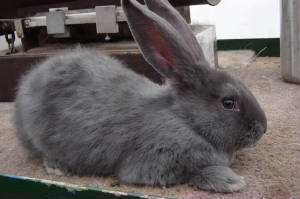
Aren't baby Flemish the cutest???
4 week old blue Flemish, already over 2 lbs.
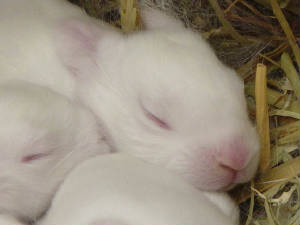
3 day old Flemish
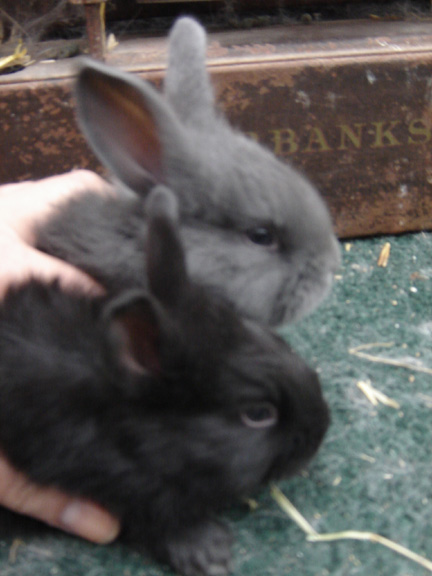
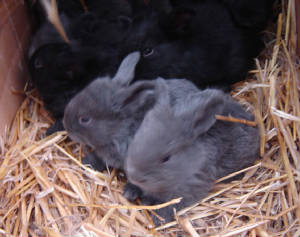
A HISTORY OF THE FLEMISH GIANT BREED
No one knows the exact origins of the Flemish Giant Breed. Some people surmise that the during the 16th and 17th century, Dutch Traders may have brought back giant rabbits from the Argentine Republic to Europe. The large rabbits of Flanders were well known at the time and may have been cross bred with smaller European rabbits. The name Flemish comes from Flanders. But because the Flemish exhibits the same body type and and appearance as the rabbit from South America, it is most likely that our favorite Giant is decended from the Argentine rabbit.
There is no verifiable record of the Flemish Giant Rabbit until 1860. Travelers from Flanders spoke of the giant rabbits raised in that country. English rabbit breeders, raising the typical 7-8 lb. rabbit, were having trouble meeting the demand for rabbit meat in their country. So some of these "Giants" were imported to England and it was only a matter of time before they began showing up at local rabbit shows. The original Flemish Giant was typically impressive in size, about 14 lbs., and of a dirty iron grey color with sandy or white bars on the legs and long ears with bent tips. Now, through the efforts of Flemish Giant Breeders Associations around the world, our Gentle Giants have evolved to 7 varieties (colors), Black, Blue, Fawn, Light Gray, Sandy, Steel and White, with typical sizes of 14-20 lbs. In the United States, the National Federation of Flemish Giant Rabbit Breeders was founded in 1915 to promote and improve the breed.
(Thanks to the National Federation of Flemish Giant Rabbit Breeders for the historical information and for more information on the NFFGRB, please see my Rabbit Links page.)

Tiara's daughter at 3 weeks old!
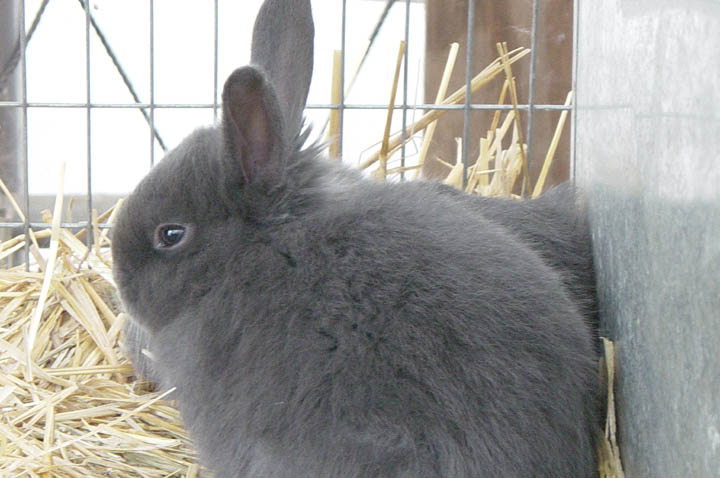
Care of your Flemish Giant:
Because of their size, Flemish Giants require a little extra consideration and care than their smaller "cousins". They need a larger cage than the average rabbit. To give them the space to grow and be comfortable, the cage should be a minimum of 24" high, 36" deep and 48" wide. (Bigger is better!) A larger door is needed on the cage to make sure the rabbit can easily be removed. We recommend a 20" tall x 16" wide doorway.
All rabbits need to be protected from direct sun, wind, rain and extreme temperatures. Most rabbits and especially the Flemish Giant do very well outdoors. The Flemish can handle cold temperatures but don't like the heat. Temperatures above 90*F. can be difficult on them. Direct sun can damage their fur. In very warm weather, we fill 2-liter soda bottles with water, freeze them and lay them in the cages. The rabbits will lay against them and even over them to cool themselves.
There is a lot of discussion about what kind of floor the Flemish Giant needs in the cage. Most rabbits are comfortable on wire floors, that allow droppings to fall through. Because of their size and weight, the Flemish can develop sores on their hocks (back feet). Some breeders keep their Giants on solid wood floors with bedding like straw or shavings. This bedding must be changed often (at least every 3 days) to prevent disease and eliminate any build up of waste and odor. We use a modified wire cage floor with 3/4 covered in plywood (or 1/2" thick white sheetrock/wallboard) that can be lifted out, cleaned or replaced. This gives them the opportunity to sit on solid floor or wire. And we provide a thick layer of straw bedding. With the back 12" open wire, all the liquid waste and most of the droppings fall through to the ground or trays below.
Most rabbits are very clean and use the same corner to eliminate. They can even be taught to use a litter pan like a cat. We recommend All Natural Kitty Litters, especially litter made from recycled newspaper (no cedar, clay or perfumes). Flemish Giants make wonderful House bunnies, if you can provide the extra space and regular exercise that they need.
A well balanced, pelletized rabbit food is best for overall growth and development. The feed should have a minimum protein content of 15-18% (check the label). The Flemish do better on a 16-17% protein diet due to their rapid growth and large size. All rabbits need daily portions of fresh clean hay (alfalfa or timothy, depending on your bunnies age, condition and adult size). Treats could be pieces of apple, carrot, orange, beet or raddish tops, endive, parsley, collard greens or clover and dandelion leaves (from an organic lawn). Don't over do the treats. Obesity will severely shorten your rabbits lifespan. Iceburg Lettuce is not a good food or treat and should never be fed to your rabbit. It can cause loose stools and severe digestive problems and has no nutritional value. Don't hesitate to consult your animal's health care professional if you have any doubt's or questions.
Just like cats, rabbits groom themselves and keep their fur clean. Fresh Papaya or Pineapple are excellent natural remedies to prevent hairballs caused by self-grooming. You can also use Papaya Tablets (available at Health Food stores and Vitamin shops) once a day in their food. The more you pet and handle your rabbit, the friendlier they'll be. We always talk to, pet and handle them every day. Handling your rabbit will give you the first indications that anything is wrong. Check teeth, feet, nails, vent, and ears for anything unusual. Look for signs of overgrown or broken teeth, overgrown or broken nails, infections, dirty ears, etc. Most problems are easily fixed when caught early.
Rabbits will not tell you when something is wrong. Being a prey animal by nature, they will try to hide injury or illness. You have to get to know your bunny so you can see when something is a little "off", and take care of it, before it becomes an emergency. Since no one knows your rabbit as well as you, if you think something "not right", consult your animal's health care professional.
Some of our rabbits enjoy walking on a leash. We use a small dog harness and leash set (NEVER use a collar on a rabbit, they can break their neck!). They don't exactly walk like a dog... they hop, you follow. Please be careful to only let them play on a lawn that has no pesticides or fertilizers. Both can be dangerous to their health.